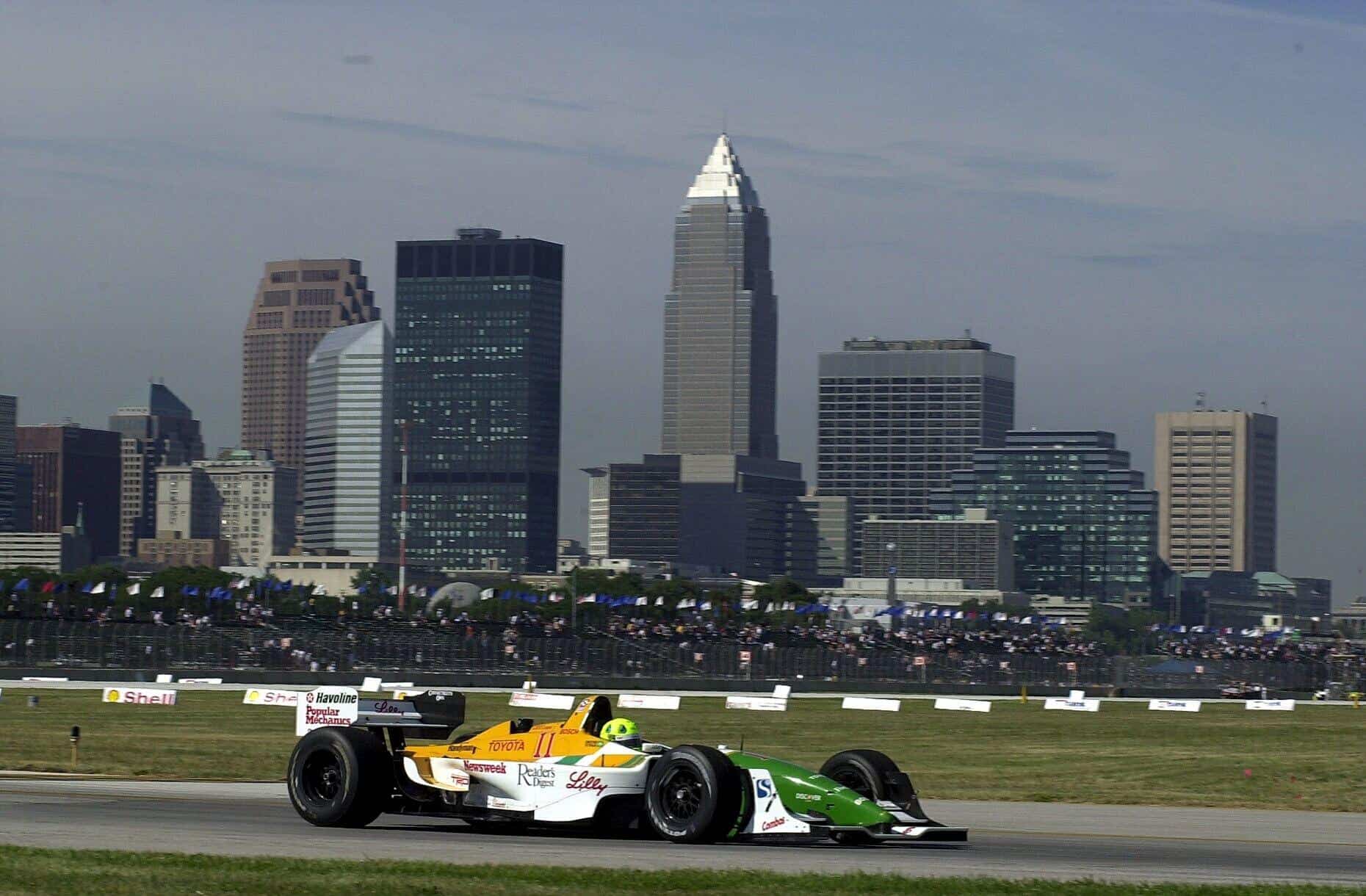Some 18 years after the NTT IndyCar Series last held the Grand Prix of Cleveland on the tarmac of Burke Lakefront Airport, it has been reported that the series is once again eying an event on the shores of Lake Erie.
On Tuesday (Sept. 30), Adam Stern of the Sports Business Journal reported that the Greater Cleveland Sports Commission had sent out a survey to local leadership, citing an “exciting opportunity” for IndyCar racing to return to Cleveland in 2028 — 21 years after the Champ Car World Series last contested the Grand Prix of Cleveland in its final season before reunification.
An important caveat is present in Stern’s report, however. He cites the series’ interest in a “potential street course race,” rather than a return to Burke Lakefront Airport.
The Greater Cleveland Sports Commission has since confirmed that a return to the city for IndyCar would be downtown, which doesn’t bode well for the idea of another race on the airport runways.
As a natural-born and long-suffering Ohioan, I can’t avoid commenting on this, as I feel a return to Cleveland is among the best decisions the series could make from a scheduling perspective in the years to come.
However, I would be remiss if I did not say that I feel a Cleveland street race fundamentally misses the point of what is otherwise a fantastic idea.
First things first, Cleveland was a great race. Up to the 2010s, IndyCar racing on airport runways was not uncommon, but Cleveland proved to have more staying power than venues like Edmonton, let alone street circuits as a whole. The circuit was easily accessible from downtown Cleveland and its flat elevation offered fans an easy view of the entire circuit. What’s more, the racing around that circuit was fantastic.
The race was a fan favorite and was slated for 2008 before becoming a casualty of the process of reunification. Several great races died with Champ Car, and Cleveland is arguably the most tragic of the events lost in the process of stitching the series back together and ending the Split.
A quick scroll through the IndyCar subreddit will show that enthusiasm, or at least curiosity, about the idea of a return to Cleveland is rampant. So, why would IndyCar be targeting a race on the streets of Cleveland, rather than a return to Burke? The answer may lie 90 minutes away in Lexington, Ohio.
The Mid-Ohio Sports Car Course has hosted American open-wheel racing since the 1970s and was a staple on the calendar by the end of the 1980s, with only a brief interruption from 2004 to 2006 since then.
However, the circuit dates back to 1961, and its facilities tend to betray its age. There’s a case to be made that, without serious upgrading, Mid-Ohio could be on its way to being unfit for hosting a major racing series. I’m thinking availability of restrooms and such.
Mid-Ohio has hosted its race around the Fourth of July weekend in recent years, certainly a coveted weekend on the calendar. If interest exists from leadership in Cleveland, the series could have some leverage in demanding Mid-Ohio bring its facilities up to a standard the likes of those at Road America, for example.
That seems feasible but less than likely. In 2025, Mid-Ohio drew a record crowd and it has already been a consistently strong event in terms of attendance. Its location, approximately halfway between the Cleveland and Columbus metropolitan areas, certainly helps, and it’s around the same driving time from the Akron metropolitan area, where another 700,000 people live.
Could IndyCar use the looming threat of a 2028 round in Cleveland to push Mid-Ohio to modernize? Sure. Will it? That seems doubtful.
Could two dates in Ohio work, then? Maybe.
Mid-Ohio’s early July spot is ideal for an Ohio track, as July is among the warmest months with below-average precipitation. Hosting another race in Ohio is not an outright bad idea, but in this economy, how many people want to spend on two sets of race tickets in close proximity to one another?
June, August and September are low-precipitation months in the Cleveland area as well. That’s not to say that IndyCar can’t race in the rain, I just know from experience that lake rain at Burke is not a pleasant experience.
Unless IndyCar wants to use Cleveland to push Mid-Ohio away from early July and buy some spread between Ohio events, Cleveland would be best suited as an early June race or a late-season special. Geographically, it would fit well two weeks out from the Indianapolis 500. From Indy to Detroit to Cleveland would be an easy logistical feat and would placate fans in the Midwest, where the series’ following is healthiest.
Either way, the cost factor needs to be addressed. Fans need to show up and they need to be willing to show up to both races if the series wants to run the play of splitting the Ohio market, especially with two tracks separated by a less-than-two-hour drive. Road America and Milwaukee are very close to one another, I grant you, but I’d argue neither Mid-Ohio nor Cleveland can match either of their respective historical weights.
Therefore, I propose that IndyCar bundles tickets for both races.
Theoretically, let’s say fans buy race-day admission for both events. Let’s take the combined cost of admission and shave 10% off of that for a two-race deal. Full weekend admission? Go for 20% off. If the series really wants to know its fanbase, it’ll throw in free parking for raceday in Cleveland as part of the bundle. Trust me, nobody has ever parked in Cleveland for a day and left without a migraine.
Therein, however, the elephant on the runway rears its ugly head again. Why is this race not being targeted, at least not yet, at Burke Lakefront Airport?
Honestly, who knows? Burke has been a hot topic in Cleveland politics forever. The city is eager to close it down and redirect its traffic and services to Cleveland Hopkins International Airport, which is a 20-minute drive away, further from the shores of Lake Erie.
However, efforts to close Burke have proven consistently futile.
The airport still moves meaningful amounts of cargo and private traffic alongside its commercial flight load. Cleveland Clinic specifically uses Burke as a hub for its fleet, which is crucial given the international demand for specialized treatment from the Cleveland Clinic and its easy transit to and from Burke compared to Hopkins or Cuyahoga County Airport.
Most importantly, the city of Cleveland cannot unilaterally shutter an airport. The city holds grants from the Federal Aviation Administration for at least $10 million, with terms set to expire in 2036. For good measure, its obligations to the state of Ohio are likely similar in terms of time and price.
It’s hard to imagine the city wants Burke gone enough to pay back upward of $10 million in grants and move the political capital necessary to expedite the process.
After decades of failed political siege driven by poorly articulated visions of generic lakefront development, I think it’s safe to say this airport isn’t going anywhere anytime soon. Even if a local administration finds the resolve or leverage to close Burke, our friends at Sherwin-Williams, Progressive, the Cleveland Clinic and perhaps a few of Cleveland-born Roger Penske’s local pals will almost certainly intervene on the airport’s behalf, IndyCar race or not.
The airport, given its staying power, is the key to making a race in Cleveland work, regardless of what those in power at IndyCar may think.
There is absolutely nothing advantageous about trying to establish and promote a temporary street circuit in downtown Cleveland. Even around Progressive Field and Rocket Arena, street space is scarce and few streets are wide enough to accommodate a paddock area.
With the Cleveland Browns looking to relocate to Brook Park, space will technically be available on the waterfront, but not much. Further, some of the buildings on that land are under lease beyond the race’s targeted date of 2028, as far as we know.
Whatever space could be gained from the demolition of Huntington Bank Field will still be dwarfed by the available racing surface on the runways of Burke Lakefront.
Finally, choosing to set up a downtown street circuit, wreaking potential havoc on local business flows, instead of going to the ready and ostensibly available Burke runways, would more than likely alienate local and legacy IndyCar fans, who have been vocal for the better half of two decades about their desire to see a local promoter make the race work once more.
Verdict?
The series’ long-awaited return to Cleveland, one that I have personally vowed to make happen come Hell or high water through sheer force of spite if necessary, should not happen in any form other than a direct return to Burke Lakefront Airport.
Right now, this is still just an idea, but one that IndyCar, regardless of its final intentions, deems worth broaching with local stakeholders. With a proper strategy to incentivize attendance and reward promoters and sponsors, a race in Cleveland could certainly coexist and even work in a mutually beneficial relationship with the established event at Mid-Ohio.
That is with one caveat. A simple return to Cleveland misses the point. This has to be a return to Burke Lakefront Airport.
Alex is the IndyCar Content Director at Frontstretch, having initially joined as an entry-level contributor in 2021. He also serves as Managing Director of The Asia Cable, a publication focused on the international affairs and politics of the Asia-Pacific region which he co-founded in 2023. With previous experience in China, Japan and Poland, Alex is particularly passionate about the international realm of motorsport and the politics that make the wheels turn - literally - behind the scenes.





